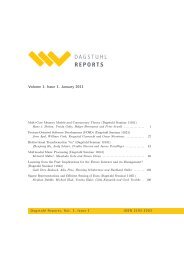Uncertainty modeling and analysis with intervals - DROPS - Schloss ...
Uncertainty modeling and analysis with intervals - DROPS - Schloss ...
Uncertainty modeling and analysis with intervals - DROPS - Schloss ...
You also want an ePaper? Increase the reach of your titles
YUMPU automatically turns print PDFs into web optimized ePapers that Google loves.
46 11371 – <strong>Uncertainty</strong> <strong>modeling</strong> <strong>and</strong> <strong>analysis</strong> <strong>with</strong> <strong>intervals</strong>: . . .<br />
3.19 Characterizing AE Solution Sets to Parametric Linear Systems<br />
Evgenija D. Popova (Bulgarian Academy of Sciences, BG)<br />
License Creative Commons BY-NC-ND 3.0 Unported license<br />
© Evgenija D. Popova<br />
Consider linear systems whose input data are linear functions of uncertain parameters<br />
varying <strong>with</strong>in given <strong>intervals</strong>. Such systems are common in many engineering <strong>analysis</strong> or<br />
design problems, control engineering, robust Monte Carlo simulations, etc., where there<br />
are complicated dependencies between the model parameters which are uncertain. Various<br />
solution sets to a parametric linear system can be defined depending on the way the parameters<br />
are quantified by the existential <strong>and</strong>/or the universal quantifiers.<br />
We are interested in an explicit description of the so-called AE parametric solution sets<br />
(where all universally quantified parameters precede all existentially quantified ones) by a set<br />
of inequalities not involving the parameters. The problem is related to quantifier elimination<br />
where Tarski’s general theory is EXPSPACE hard <strong>and</strong> a lot of research is devoted to special<br />
cases <strong>with</strong> polynomial-time decidability.<br />
In this talk we present how to obtain an explicit description of AE parametric solution<br />
sets by combining a modified Fourier-Motzkin-type elimination of existentially quantified<br />
parameters <strong>with</strong> the elimination of the universally quantified parameters.<br />
Some necessary (<strong>and</strong> sufficient) conditions for existence of non-empty AE parametric<br />
solution sets are discussed, as well as some properties of the AE parametric solution sets.<br />
Explicit description of particular classes of AE parametric solution sets (tolerable, controllable,<br />
any 2D) is presented.<br />
Numerical examples illustrate the solution sets <strong>and</strong> their properties. A comparison to<br />
results obtained by quantifier elimination demonstrates the advantage of the presented<br />
approach.<br />
3.20 What you always wanted to know about decorated <strong>intervals</strong><br />
John D. Pryce (Cardiff University, GB)<br />
License Creative Commons BY-NC-ND 3.0 Unported license<br />
© John D. Pryce<br />
Work on an Interval Arithmetic St<strong>and</strong>ard has been under way since 2008, in IEEE Working<br />
Group P1788. Early on, we chose a “silent” paradigm for function evaluation, namely interval<br />
evaluation of a library function partly or wholly outside its domain returns an enclosure of<br />
those values that are defined (e.g. 1/[0,1] gives [1,infinity); sqrt([-2,-1]) gives the empty set),<br />
instead of throwing an exception as in current interval systems.<br />
This raises the question of how to record that such an exceptional event has occurred.<br />
This is necessary, since various important interval algorithms need to determine rigorously<br />
whether a function, given by an expression, has properties such as being defined, or defined<br />
<strong>and</strong> continuous, everywhere on a box. Examples are branch-<strong>and</strong>-bound search methods to<br />
“pave” space regions defined by inequalities; or validated ODE methods that apply Brouwer’s<br />
fixed-point theorem. In current interval systems, such information can only be determined<br />
to a limited extent, <strong>and</strong> by clumsy ad hoc means.<br />
Summarising discussions over the past 15 months, this talk aims to show why <strong>and</strong> how it<br />
is feasible to record such data automatically by suitably enhancing the interval versions of













